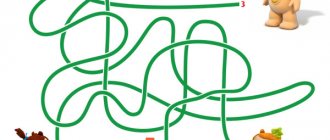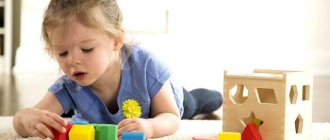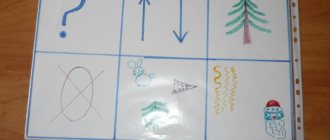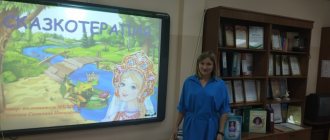Speech therapy games made by teachers and educators are aimed at developing breathing abilities and include articulation exercises and games with air. To form a syllable structure, a variety of activities are used to reinforce the skill of dividing words into syllables. Various variations in the formation of the basic phonemes of the Russian language. Many exercises using visual material are devoted to the development of the articulatory apparatus.
The games proposed below were developed by preschool teachers and speech therapists and are used to increase work efficiency and diversify the material used in the correctional process.
Didactic games for speech therapy classes with preschoolers
Speech therapy educational games for preschoolers
Educational games Author: Tatyana Vasilievna Chervyakova, speech therapist, MDOU kindergarten “Rodnichok” Description: The presented didactic games will be useful for speech therapists and kindergarten teachers. The material is intended for conducting individual and subgroup speech therapy sessions with preschoolers.
Purpose of the game: to activate vocabulary on the topic “Vegetables” and “Fruits”; Teach children to divide words into syllables. Material: drawings: planar images of baskets with syllabic patterns, images of objects - vegetables and fruits. Progress of the game: Speech therapist. Guys, today we are going to visit our grandparents in the village to see what vegetables have grown in the beds. – And then our grandparents meet us.
Speech therapist. Grandma invites you to guess what vegetables they collected. – round, red, juicy, healthy, soft... (tomato) – oval, green, crunchy, rough, hard... (cucumber) – oblong, orange, hard, tasty, vitamin... (carrot) – round, bitter, hard, healthy ... (onion) - round, green, juicy, crispy... (cabbage)
Speech therapist. Guys, you guessed all the vegetables. Now let's put them in baskets. – Notice what beautiful baskets grandma prepared. Each basket has a syllabic pattern. Let's name the vegetables one by one, determine the number of syllables in each word and put the vegetable in the correct basket.
A similar game can be played on the theme “Fruits”. As material we use images of objects - fruits.
Didactic game “Syllable Houses” Purpose of the game: to teach children to break words into syllables. Material. Airplane images of houses with window pockets. Every house has a syllabic pattern. Images of objects depicting fairy tale characters: Wolf, Carlson, Dunno, Pinocchio, Malvina, Puss in Boots and others. Progress of the game. Speech therapist. The heroes of fairy tales came to visit us. Nominal. Child. Wolf, Carlson, Malvina, Pinocchio, Aibolit.
Speech therapist. Guests should be “settled” in houses. Determine the number of syllables in each word and “place” the hero in the desired house.
Child (speak and emphasize the syllables) - “Karl the Son” - two syllables (puts the photo in the pocket of house No. 2) - “Wolf” - 1 syllable (puts the picture in the pocket of house No. 1).
- “Mal-vi-na” - this word has three syllables (puts the picture in the pocket of house No. 3) - “Bu-ra-ti-no” - the word has four syllables (puts the picture in the pocket of house No. 4)
Speech therapist. Very good! The manual can be used when studying other lexical topics.
We recommend watching:
Speech therapy games for preschoolers Games for the prevention of optic dysgraphia and dyslexia in preschoolers Speech therapy games for kindergarten using animals Do-it-yourself speech therapy board games for kindergarten
Similar articles:
Speech therapy games for preschoolers and primary schoolchildren
DIY speech therapy games for preschoolers
DIY speech therapy games
Speech therapy game for older preschool children
Speech therapy game for children 5-8 years old “Who is faster”
Speech therapy tasks
Starting with the letter R
Summary of nodes on teaching literacy in the preparatory group. theme “sound and letter w”
One of the most difficult sounds to master is R. Many preschoolers learn to roar loudly by the very end of kindergarten. If the production of the sound P is already behind you, then special exercises will help speed up its automation:
1. “Like a little motor”
We ask the child to pronounce the sound R in the word for a long time, drawlingly (like a motor growls).
2. “Where is R hiding?” (in pictures and words)
Offer to choose pictures with images of objects with a given sound or clap your hands if he hears such a word.
3. “How can you growl?”
Show your child pictures of objects that have the sound r in their names. Offer to read and color the picture.
4. “Sounding tracks”
Together with your child, come up with several chants made up of several syllables:
Ra-ra-ra - they ran away from the yard.
Ro-ro-ro - and they found a bucket.
Ru-ru-ru - we came up with a game.
5. “Substitute a syllable”
The adult offers the child words that end or begin with a syllable with P (ra, ro, ry), the child must choose the correct option and pronounce it correctly.
6. “Look and name”
An adult asks the child to read words with the letter r from the pictures. The word must be said as many times as there are stars next to each picture.
7. “Poems, tongue twisters, riddles”
Learn with your child several poems and riddles in which words with R appear.
Starting with the letter L
The hard sound L is also often difficult for children 5-6 years old. If the baby has already learned to pronounce it alone, in isolation, then it’s time to start working on automation in speech. The following exercises are suitable for this:
1. “Say it nicely”
Offer your child several images of words starting with L. Ask him to pronounce the words beautifully, emphasizing the desired sound with his voice.
2. “Toys for Larisa”
Ask your child to collect gifts for the Larisa doll. Tell her that she only likes things that begin with L. For this exercise, you need to select small objects or pictures in advance; all words should not begin only with L.
3. “One-many”
Invite your child to name words with L in the singular and plural. In the workbook for the sound L (author Kostyuk A.V.) there is a whole table with pictures for this exercise (lesson 20).
4. “Find the Sound”
Invite your child to draw up a diagram of the word and mark the place L on it. If it is still difficult for your child to independently determine the number of sounds, then first you can do several similar exercises from the workbook.
5. “Tongue twisters and nursery rhymes”
Use nursery rhymes, tongue twisters and poems with words that contain L.
Starting with the letter Sh
Difficulties with hissing in children 5-6 years old are also quite common. The following games are suitable for automation:
1. “Who’s hissing?”
Invite your child to choose several pictures of those who can hiss. Ask them to say their “song” clearly, loudly, and for a long time.
2. “Catch the Sound”
Ask your child to clap their hands every time you say Sh or a word with that sound (among others).
3. “Syllables Travel”
Take a card with one of the syllables SHA, SHO, SHU. Offer to come up with words or several that begin with this syllable and end with it (Sha-ry and ka-Sha, sho-rokh and ho-ro-sho).
4. “What are the guys’ names?”
Ask your child to read the children's names, adding the syllable SHA at the end.
4. “We compose speech therapy rhymes”
Come up with short rhythmic chants with the syllables SHA, SHO, SHU, SHI.
Sha-sha-sha - the porridge ran away,
Sho-sho-sho - have a good rest,
Shu-shu-shu - dry mushrooms and berries.
5. “Speak beautifully and correctly”
Ask your child to pronounce words with the Sh sound correctly.
The use of workbooks not only allows you to properly organize speech development classes for children 5-6 years old, but also makes it possible to train graphic skills, attention, thinking, and imagination. To reinforce the material, also use video lessons:
To reinforce the material, also use video lessons:
The role and significance of speech therapy games
The process of further development of the child depends on how well the speech is formed. That is why it is so important to promptly prevent various defects and monitor the purity of the sounds produced by the baby. Violations are noted not only in the speech of a preschooler, but also in perception and production itself. When determining the degree of the defect, all symptoms associated with mental, physical and speech development are identified.
Language educational games
Note! Play is the main activity of a child; with its help, he masters various forms of thinking and develops his horizons. Speech therapy games play an important role in creating a favorable environment for a child to overcome speech disorders of varying severity.
Speech therapy educational games for preschoolers have great potential: with their help, the student works on correct pronunciation of words, learns their native language and learns the rules of grammar in a simple form. Difficulties overcome in this way in a playful way are less obvious and tangible for the child.
The main significance of speech therapy games is to increase the vocabulary and horizons of children, expand the boundaries of the child’s consciousness and introduce him to the world around him.
How games help a speech therapist
Every year the percentage of preschool children with speech pathologies of varying complexity and etiology increases. To correct standard speech disorders, you need to practice at least 2-3 times a week for 30 minutes. However, it is difficult to captivate children with a monotonous task; they quickly get tired and refuse to complete the exercises suggested by the teacher. To increase motivation for learning, speech therapists use game techniques in their classes, thanks to which the correction process ceases to be boring for the child.
What else to read: Children and the world around them: didactic game “What is made of what?”
Speech therapist and child
Exercises to improve phonetic-phonemic processes
At the age of 6-7 years, a preschooler should be able to distinguish sounds by ear; understand which are consonants and which are vowels
Particular attention is paid to work on sound-letter analysis. In a playful way, the speech therapist teaches children to draw up diagrams of words and sentences and determine their boundaries.
Thus, the foundation for successful mastery of writing skills is formed.
Work is carried out in the following areas:
- highlighting the initial and last sound in a word;
- selection of an image in accordance with a given phoneme;
- tasks for distinguishing between hardness and softness;
- the concepts of “sound”, “syllable”, “word” are fixed.
When offering tasks to improve phonetic-phonemic processes, the speech therapist pronounces words loudly so that all sounds are clear. All vowels must occupy a strong position so that the child can successfully master the skills of sound-letter analysis. To conduct games, visual material, diagrams, and circles are used to indicate vowels and consonants.
When working with children aged 6-7 years, they include voiced-voiceless consonants; learn to distinguish between hard and soft. But in order to complete such exercises, the child must have developed phonetic-phonemic processes, otherwise difficulties may arise when completing the task. Therefore, the teacher carries out preliminary work, explaining the difference between voiced and deaf on the basis of tactile control. Gradually, the child learns to distinguish them only by ear.
"Live Sounds"
This game is aimed at strengthening the skills of sound-letter analysis. To carry it out, you need to prepare cards with letters and pictures. It is suitable for group classes.
The adult shows the children a picture and says the word. The guys need to compose it themselves. Each child has a card with a specific letter. They line up in a row so that you can read what happened.
"Divide into groups"
The purpose of the exercise is to improve skills in working with sound-letter analysis, the ability to isolate the sound at the beginning of a word. To carry it out, you need to prepare cards with words that begin with different phonemes. The child divides words into groups depending on the initial sound. First, you can pronounce the names out loud, then the exercise is complicated - the child pronounces them independently or silently.
"Sound Lotto"
This didactic game teaches the child to work with a word - divide it into parts and determine where the sound occupies. For the lesson, prepare strips divided into three equal parts; subject pictures with the required phonemes in the title.
The child is shown a card, he says the name, and decides where on the strip to place it. Before starting the game, they carry out preparatory work and explain what should be considered the beginning of a word, its middle and end. This is a more complex task that allows you to consolidate the skill of working with sound-letter analysis. But before that, you need to separately practice the ability to identify sounds in different places in a word.
Speech therapy games with a flashlight for children
Games with light are spectacular and exciting, and the flashlight is accessible and safe for children. The game was developed by teacher Natalya Konyakhina. For the game you will need sheets of paper from which the box will be made. You will also need drawings that can be printed on a printer or downloaded from the Internet (shoes, clothes, fruits, vegetables, animals and any other items studied in preschool). Items need to be cut out and glued inside the box so that the front side faces the baby. The child points a flashlight at the wall and answers the questions: “What do you see?”, “Whose shoes are these?”, “Is there an apple in the box or many?”
Underdevelopment of phonetic-phonemic speech in preschool children
Note! Games with a flashlight make it easy for a preschooler to develop coherent speech.
Child with a flashlight
Exercises to enrich vocabulary and correct grammatical structure
Speech therapy classes in the preparatory group
In 6-7 year old children, speech is practically no different from the speech of an adult. They can easily talk about a subject they know, use more clarifying words, and give detailed answers. With the improvement of coherent speech, the development of the grammatical structure of speech also occurs.
Didactic games are aimed at clarifying existing concepts, expanding vocabulary and consolidating acquired grammatical skills, such as word formation and agreement. In addition to nouns and adjectives, in classes with older preschoolers they practice verbal vocabulary, numerals, adverbs and pronouns.
"Who can name more"
In addition to expanding vocabulary and strengthening the ability to generalize, training of motor skills and coordination of movements is needed. Children are asked to name as many words as possible that belong to a certain category. The adult throws the ball - the child says the word.
"Tender name"
During this game, the skill of suffixing words is put into practice. During classes, visual material is used - pictures or toys. The adult says that this object can be large or small. The child needs to name him affectionately, adding a suffix.
"Introducing Antonyms"
An adult shows pictures that depict words with opposite meanings. The child’s task is to choose the right antonyms. You can complicate this task if you use not only nouns and adjectives, but also verbs.
“Whose is this?”
This task is aimed at consolidating the use of possessive adjectives in the child’s active speech. It is best to start education from the names of animals. Children are shown matching images and need to answer the questions: “Whose is this, whose is this?”
"Name the action"
During this game, the teacher teaches children to select an action for an object and name the appropriate verb. Since this exercise requires a ball, motor skills are also improved. The adult throws the ball and names a noun, the child must respond with a suitable verb. For example, a doctor treats, a teacher teaches, etc.
"How many items"
By completing this task, the child strengthens the skill of counting and agreeing between nouns and numerals. Show pictures with different numbers of objects. The preschooler counts them, naming the numerals paired with a noun (one tomato - two tomatoes, three tomatoes, etc.).
Didactic games for the development of speech of preschoolers card index on speech therapy on the topic
Reminder for parents
“We talk, we play – we develop our discourse”
DEAR PARENTS!
Talk to the kids!
There is a lot of talk about how good language development is a prerequisite for academic success. However, parents do not always know how to develop this speech.
You can often hear: “We read a lot to the child, read poems, talked about everything, but there was no result; The child himself cannot describe the simplest image or tell anything.”
How could it be otherwise: after all, it was the parents who said it, not the child. Babies are all different - some are unstoppable, while others say nothing. But even the “silent” will speak if there is an incentive to speak out.
The performance begins with the desire to communicate!
No matter how imperfectly your child speaks, accept his desire and indulge him. Even if he doesn't speak at all, often engage him in nonverbal dialogue, welcoming and approving any response (gesture, expressive look). At the same time, try to give him the opportunity to listen to himself and himself. Especially create play situations where the child will need onomatopoeia or will have to say a few words for the game to take place. Keep in mind that it is not you who motivates, but the situation. Mood.
Try to pronounce a new word in an emotionally favorable situation: when the child is calm, in a good mood, in such conditions the child assimilates and assimilates information 10 times better than neutral or unfavorable information.
How can you develop speech?
1. Whether you are looking at an image, reading a book, draw your child’s attention to rare phrases, ask what this or that word means.
2. Play the game “Tell Me the Word”: an adult reads a short poem, and the child must guess and name the last word in it.
3. Play with words. This can make a long journey in transport, or the need to lie in bed, cheer up. These tasks include:
- what words, colors can describe the time of year, tell about the topic, what it is about (quote as many adjectives as possible);
- what he can do (name as many verbs as possible)
- play a bad and a good game. What is good about Baba Yaga and what is bad? What is good in the rain and what is bad?
- play opposite words (opposites)
4. Invite your child to tell a story, story, or cartoon. Ask what you liked and why. Ask to describe your favorite character.
5. Play the game: “Find the error in the sentence”
6. Teach your child to make a story from an image. Explain that a story has a beginning (as short as the morning), a center (as the day), and an end (as short as the evening).
7. Play a familiar fairy tale face-to-face with different intonations.
Remember! It's very easy to knock over a child. Treat your child with understanding.
Expand your child's vocabulary.
A child has words on two levels: he understands words - this is passive vocabulary, he speaks - he is active. The active vocabulary can be quite small. Try entering the names of things around it (toys, household items), the names of family and friends into the active dictionary. More often they ask: “Where is the table? Where's the clock? ”etc. This will certainly lead to an increase in vocabulary. Develop phonemic awareness (the ability to hear different speech sounds) by encouraging different sound words. (roof – mouse, nose – knife).
Read to your child.
Read short poems and fairy tales. Read them many times: don’t be afraid that your child will get tired of it. Children learn much better from texts they have already heard. If possible, try to quote the poem - show it with faces and objects; and let your child play with objects. Wait until the child has a good memory of the poem, get a feel for the rhythm, then try not to finish the last word of each line, allowing the child to do so. Sing simple songs to help him feel the rhythm and play it.
What else to read: Didactic game “Guess the sport.” presentation on physical education
Fingers help the word.
Pay attention to the development of fine motor skills - precise finger movements. Modeling, drawing, finger theater, playing with small objects - all this will help speech, and in the future, writing. The child should work with naughty fingers as much as possible. No matter how boring it may seem, let the child button up his buttons, tie his shoelaces, and roll up his sleeves. It is also better to start training not with your own clothes, but first “help” the doll and even the parents get dressed. As a child's fingers become more dexterous, his speech will become more understandable to others. About the benefits of joint gymnastics in the development of a preschooler.
Joint gymnastics in the development of preschoolers.
Gymnastics for arms and legs is familiar to us. We train the muscles so that they become flexible, strong and agile. But why train? It turns out that the tongue is the main muscle of the speech organs. And like any muscle, it simply needs gymnastics. After all, the tongue must be well developed to make the subtle, intentional movements that produce speech sounds.
Pronunciation deficiencies aggravate the emotional and mental state of the child, preventing him from developing and communicating with peers. To prevent this problem from arising, you should start doing gymnastics for your joints now. With the help of articulatory gymnastics, existing violations of sound pronunciation are overcome.
At first, gymnastics should be done in front of a mirror. The child must see what his tongue is doing and where it is. In this case, the movements of the tongue are brought to automaticity by constant exercises. Work with your child every day for 5-7 minutes. Carrying out articulatory gymnastics in the form of a fairy tale (in a funny language) will help turn the exercises into an exciting game.
Believe in yourself!
Remember: only you and your faith in the child’s strengths and abilities can help him develop harmoniously. Be patient, kind and calm and you will succeed.
Development of fine motor skills to prepare the hand for writing.
It has now been shown that the development of fine motor skills of the fingers has a positive effect on the speech development of children. Employees of the Institute of Physiology and Adolescence of the Academy of Pedagogical Sciences of the Russian Federation determined that the projection of the hand to the brain is very close to the area of the speech motor. The relationship between the motor and speech zones is also manifested in the fact that a person who has difficulty finding a word helps himself with gestures, and vice versa: a child focused on drawing or writing involuntarily sticks out his tongue.
Therefore, training the movements of fingers and hands is the most important factor that stimulates the development of a child’s speech, helps improve articulatory movements, prepares the hand for writing, as well as a powerful tool that increases the performance of the cerebral cortex and, as a result, the level of development of thinking.
Activities that develop fine motor skills.
Have a beneficial effect on the development of hand and finger movements:
- massages and self-massage;
- finger gymnastics;
- visual activity;
- modeling;
- drawing;
- statement;
- handmade;
- manipulations with various objects: collecting pyramids, nesting dolls, builders, mosaics; unfastening and fastening buttons, Velcro, straps; lacing.
- shading, writing.
Games and exercises for children 2-4 years old.
Magic bag.
Examine toys and objects with your baby and touch them. Invite your child to touch one of the items in the bag, name it, and pick it up. Without removing the object, touch it, name it and describe it.
Tactile tables.
it is necessary to prepare a series of boards with different structural surfaces; with images of various objects cut out along the contour.
Tasks: with eyes closed, feel the outline and name the depicted object; find a specific image of an object with your eyes closed; find two identical cards.
Finger pool.
Tasks: lower your hands to the pool of fingers and touch the beans or peas; move to another container one by one; clench and unclench fists with beans and peas while holding hands in the pool; touch this object.
I turn and turn.
(Tasks with various massage balls, sticks, chestnuts, nuts, etc.)
Throw and grab an object with one hand, two hands, unfold an acorn or pine cone. Roll a massage ball or stick: with your palm, the edge of your palm, the finger of one palm towards the other, between your palms, on the back of your hand with rotational movements in one direction, in the other direction, vertically. Gradually increase pressure and rotation speed.
Rope.
Tasks: tie and untie knots; twine: remove the beads, twist the lace between the tips of the thumb and forefinger, wind the lace on a stick or thread on a spool, braid a pigtail, intertwine fingers with lace, decorate patterns and figures with lace.
Clothespins.
Tasks: use clothespins to hook a sheet of paper, the edge of a box or cup, or a rope; open and close the clothespin with your thumb and index finger, thumb and middle finger, etc. Ask your child to count the number of clothespins on the string, and only put clothespins of a certain color on the string.
What else to read: Didactic game “Put butterflies on flowers”
Exercises with vocal accompaniment.
Fox.
Rhythmic opening and closing of a clothespin while pronouncing the text:
“Clever scammer, redhead. The mouth opens, it scares the rabbits.”
Crow.
Bend your hand towards the table and take the candy wrapper. Then the brush returns to its original position. Talk:
“I saw the paper and how to take it. I thought it was candy, but it turned out to be a candy wrapper.”
Dogs.
The exercises involve both hands, which rhythmically open and close clothespins while pronouncing the text:
“Two dogs bark, don’t bite. Two cubs walk around in the nest all day, screaming, opening their mouths to the crows, and really want to eat.”
For children 5-7 years old.
Finger gymnastics, games with letters and words. As a physical exercise, it is very good to use finger exercises with speech accompaniment. The dictionary has dozens of poems on every topic. For example:
The sky in Russia is blue
The rivers in Russia are blue – they bend like your finger.
There are maples and oaks, the fingers represent “branches”
What kind of mushrooms are there? The fist of one palm is covered with the other open palm.
Children love to speak in a secret language. Create your alphabet with your fingers. Use it to guess letters and then form words. [2]
Arrange the figures, counting sticks and matches.
Finger Theater. They develop attention, thinking, memory, stimulate the baby’s speech development, help relieve tension from the hands and lips, relieve mental fatigue, develop arms, become more mobile and flexible. Advise parents to take their children to a real theater to see various children's performances.
Written works, various types of shading, coloring of figures, pictures.
Currently, there is a large selection of literature on this topic. You can purchase it to your liking, but make sure the instructions are appropriate for your child's age and difficulty level.
Finger games
Finger gymnastics together with texts helps develop thinking, imagination, attention and express your emotions. In addition to the development of speech, there is also the appearance of a quick reaction
You should exercise every day for 5 minutes. There are many exercises, but a good place to start:
- Flower. The arms are folded as if in prayer. The kid says: the sun wakes up, the flower opens (fingers unclench, palms clenched), the sun sets, the flower goes to bed (palms close again).
- Cat. Hands on the table, clenched into a fist. The baby says: “fist-palm, I walk like a cat.” Unclenches his hands, does not lift his palms from the hard surface, and then returns to the starting position. Repeat 7 times.
- Bird. Cross your arms in front of your chest, palms facing you. Interlock your thumbs, they symbolize the head of a bird. Fingers are wings. The bird flew (wave your fingers), sat down and turned gray (separate your palms and press them to your chest), then flew on.
Such games can be used during moments of relaxation, on a walk, at home, or on a trip.
How to conduct classes at home
For many children, homework is much more fun than with a specialist. The child sees his mother or any other person he knows and feels safe. To get the most out of your lessons, you can purchase special guides that not only explain in detail how to set up and automate each sound, but also record the results. An example is N.V.’s speech therapy notebook. Sokolova.
Methods for correcting general speech underdevelopment in preschool children
For your information! Initially, speech therapy games should be accompanied by a voice explanation from an adult. After this, only the child should speak (or try to speak.
Speech therapy games for setting the sounds Ш and Ж
These sounds require a flattened position of the tongue, with the tip pressed against the upper palate. This can be achieved using the following exercises:
- "Shoulder". Stick out your wide tongue and place it on your lower lip.
- "Brush". Run the tip of your tongue from your teeth to your throat and vice versa.
- "Delicious jam." He licks his upper lip as if licking sweetness.
Speech therapy games for setting the sounds L and R
Both sounds require tension of the tip of the tongue against the roof of the mouth. However, the exercises for setting up sounds will be different.
Setting the “L” sound:
- "Punish your tongue." Extend and spread your tongue over your lower lip and lightly bite it with your upper teeth, making a “roo” sound.
- Alternating “spatula” and “back”. The tongue is spread over the lower lip or tense and is in the middle of the half-open mouth.
- "Horse". The purpose of this exercise is to teach the child to click by pressing the tongue against the alveoli behind the upper teeth.
Setting the "R" sound:
- "Car". Open your mouth wide, press your tongue against the upper tubercles and quickly say “ttt”, simulating automatic fire.
- "Brush your teeth". Run your tongue behind your upper teeth to the right and left.
- "Swing for children." Open your mouth and place the tip of your tongue directly on your upper lip, then on your lower lip.
Speech therapy games for setting the sounds Z, S and C
Normally, a child pronounces whistles correctly at 4 years of age. Exercises to help reproduce these sounds:
- Alternating a smile with the “Tube” exercise. Smile widely, hold this position for a few seconds, then purse your lips.
- "Pendulum". Open your mouth and point the tight tip of your tongue from the right to the left corner.
- "Slide". Place the tip of your tongue on your lower teeth and lift the middle palate above the upper palate, forming a cusp.
Important! When explaining the exercise, be sure to have a tabletop mirror with you, in which the child will see his reflection.
Each exercise must be repeated six times, the total execution time should not exceed 2-3 minutes. When trying to correct the situation, do not put a dirty hand in your baby’s mouth. If it is not possible to purchase special tools for a speech therapist (spatula), in case of forced contact with the child’s oral cavity, you can use a teaspoon, first sterilized in hot water.
Mirror in speech therapy games
Topics for classes for speech therapists
When working with children, a speech therapist can take on many different topics. helping kids develop speech skills. Below are some of the most popular options.
Theme "Professions"
During these classes, various specialties are considered, involving children in games and a variety of activities. They are given riddles related to the activities of adults. Children are given exercises that imitate the movements of workers.
Conducting a speech therapy lesson in the preparatory group on the topic “Professions”, children are taught to talk about various types of occupations of adults.
Various sounds and words are pronounced with children, they are taught to make facial movements expressing certain emotions.
Theme "Winter"
When a speech therapy lesson is held on the topic “Winter,” riddles are offered on the topics of winter weather and events related to this period. Conversations related to this time of year are held with children. Kids are asked to describe winter weather using different words. For example, “What the frost does / Pinches, bites.”
Theme "Transport"
The children are considered different types of transport and given tasks that relate to them. For example, kids look at cards with pictures and must determine which is the odd one out (pictured: a car, a train, an airplane and a pan). Children must explain their choice. You can do the exercise “The steamer is humming”, used in speech therapy.
Note! In this case, while exhaling with their mouth closed, children should pronounce the long sound “oo-oo-oo”
Furniture theme
Boys and girls of preschool age are asked to name pieces of furniture located in the room. They are asked what different parts of a chair, table or cabinet are made of. A game can be used when the qualities of furniture are named, and the child must name the opposite property.
Theme "Indoor plants"
You can play the game "To". Children are told how to care for plants, and they must add the word “to” and say why exactly this should be done. The “Two and Five” game involves saying a sentence like “I have two cacti and five cacti” about various houseplants. Children with OHP are asked to say various sentences, talking about what the ladybug does. For example: “A ladybug flies over a flower.”
Recommendations for their use
It is impossible to use only ICT (information computer technologies) in speech therapy classes, because it harms vision and the child may get tired of working with the computer, even if he plays on it. By following certain recommendations, their use will be productive and will not harm your health:
- It is enough to use 1-2 didactic games, the duration of which will not exceed 5 minutes.
- You need to choose in accordance with the goals and lexical topic of the lesson.
- Their use is effective at the stages of automation and differentiation.
- The distance between the screen and eyes should be at least 50 cm.
- When playing, the child should have a straight back.
- After completing it, you should do a short exercise.
Speech therapy games on the computer should facilitate the correction process and make it more productive, increasing the child’s interest in learning. But without causing harm to health and without creating dependence on the computer
Therefore, it is important for a speech therapist to find a balance between the use of modern technologies and classic didactic games






